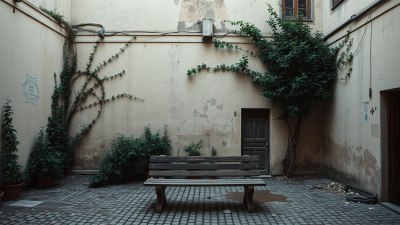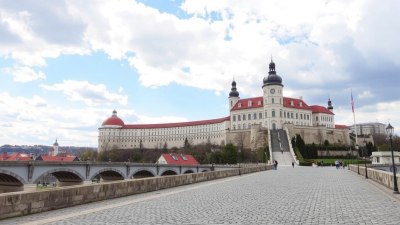Echoes in Empty Courtyards
Explore the haunting beauty and stories behind empty courtyards. A reflective journey through solitude and silence.

Image created with Flux Schnell
Courtyards have long been spaces of gathering, joy, and community; however, when they lie empty, they whisper a different tale. The echoes in these desolate places may tell stories of the past—memories of laughter, footsteps, and conversations gone silent. Each corner may hold a shadow of what once was, creating an intriguing atmosphere that stirs curiosity and reflection. This exploration into empty courtyards invites us to delve deeper into their significance and the profound silence that envelops them.
The Architecture of Memories
When you walk into an empty courtyard, you're greeted not just by physical structures, but by the architectural remnants of communal life. The walls, often adorned with peeling paint or creeping vines, hold stories of countless interactions. A single bench might recall joyous afternoons where children played, families gathered for barbeques, or lovers shared stolen moments. The cobblestones may still resonate with lively footsteps, yet now they lie still, buried under layers of dust and time.
As the sun sets, casting elongated shadows, these courtyards transform into haunting spaces. The fading light reveals the intricate details of the surroundings—a rusted swing set, an empty fountain, or perhaps a forgotten bicycle leaning against the wall. Each object is a testament to a bygone era, and the courtyard becomes a theater where ghosts of laughter and conversation whisper to the curious onlooker.
The Aesthetic Value of Silence
Silence in an empty courtyard speaks volumes. In our fast-paced world, where noise is often a sign of life and vitality, the quietude found here provides a stark contrast, inviting introspection. The calming atmosphere can ease the mind, helping us reconnect with ourselves. Many find solace in these empty spaces; artists may be inspired to paint, writers can find words, and thinkers can observe their thoughts without distraction.
Photographers, too, revel in the surreal beauty of these courtyards. The play of light and shadow against aging bricks tells a unique story, capturing the essence of solitude. Each click of the shutter immortalizes the stillness, allowing the viewer to experience not just a visual but an emotional connection to the emptiness portrayed.
Cultural Perspectives
Cultural interpretations of empty courtyards vary across regions. In Mediterranean countries, for instance, courtyards are often seen as extensions of homes, linking the indoors with the outdoors. When these spaces empty out, they reflect a deeper narrative about community and belonging. In contrast, Asian cultures may perceive empty spaces as opportunities for contemplation and peace, providing a contrast to the bustling lives people lead.
No matter where one is in the world, empty courtyards provoke thought about human connection, isolation, and memory. They challenge us to consider our place within the fabric of community and the impact of absence as much as presence.
The Role of Nature
Nature’s reclamation of empty courtyards is a poignant sight. As plants push through cracks in the pavement or vines curl around neglected structures, a powerful metaphor emerges—the resilience of life. Nature intercedes where human presence has diminished, reinforcing the notion that the cycle of life continues despite abandonment.
In many instances, gardens can form around these empty spaces, inviting bees and butterflies that may signal renewal. An empty courtyard can become a sanctuary for wildlife, showcasing the power and beauty of nature in reclaiming what is lost. In this way, the silence and emptiness are filled with the gentle sounds of life returning. Perhaps the echoes of the past are replaced with the symphony of nature, creating new stories to be told.
Symbolism of Emptiness
Emptiness often carries a weight of symbolism, representing both loss and potential. In literature and art, empty courtyards frequently serve as motifs for internal exploration. They can evoke feelings of nostalgia, evoking memories of what once was while also stirring hope for what may come.
As one contemplates the silence within these spaces, it becomes a metaphor for personal introspection, encouraging individuals to explore their inner landscapes. The courtyard stands as a blank canvas—a place to explore emotions, dreams, and thoughts without the noise of the external world clouding one’s vision.
Rediscovering the Courtyard
As society becomes increasingly urbanized and spaces grow denser, it’s crucial to recognize the value of courtyards, even those that are empty. These neglected areas can be revived into vibrant community hubs that foster social interactions. Designed thoughtfully, an empty courtyard can become a multicultural meeting point, where laughter and chatter resonate once again.
Ideas for revitalizing empty courtyards include community gardens, art installations, or performance spaces that invite local artists to engage with the community. By rejuvenating these spaces, we can blend the echoes of the past with the vitality of the present, creating a harmonious balance between solitude and togetherness.
Embracing Echoes
In conclusion, empty courtyards serve as poignant reminders of the passage of time, soundtracking changes in life and community. They invite us to listen to the echoes of history while offering a space for personal reflection on our loneliness and connectivity. The silent beauty of these spaces captures our imagination, provoking us to ponder what has been lost and what can be revitalized.
As we walk through these deserted realms, let us remember that every echo has a story to tell, and every empty courtyard has the potential to flourish anew. Embracing this duality of emptiness—both the melancholic memory and the promise of renewal—may allow us to cultivate a deeper appreciation for the intricate tapestry of community and solitude.











